ISSN ONLINE(2319-8753)PRINT(2347-6710)
ISSN ONLINE(2319-8753)PRINT(2347-6710)
Vasanta V Cholachagudda 1, Udayakumar P A 2, Ramalingaiah 3
|
| Related article at Pubmed, Scholar Google |
Visit for more related articles at International Journal of Innovative Research in Science, Engineering and Technology
Polymer matrix composites are gaining more importance compare to monolithical materials as being more reliable and cheaply available. Polymer matrix composites finding application from household to engineering approach. With the advancement of PMC‟s their properties have been increased by one the addition of one more fiber made as hybrid composite which boost the property of PMC where a single fiber composite lags. In our project we have chosen coir fiber as the major reinforcement and rice husk as an additional fiber to improve the mechanical property of polymer composite with vinyl ester as the base material prepared by hand layup process according to ASTM standards. Test specimens are prepared with different weight fractions of coir fiber at the optimization point of tensile test a small percentage of rice husks are added and tests were conducted and the improvement in mechanical properties (tensile strength and flexural strength) of the hybrid composite material is observed. With the SEM analysis the conclusion of the project is made for compatibility of coir and rice husk with Vinylester and the interfacial bonding between matrix and reinforcement is observed
Keywords |
| Vinylester, Rice Husk, Coir, Hybrid Polymer Composite, Tensile and Flexural Strength. |
INTRODUCTION |
| The present research work is more interested in preparing a composite made of natural fiber as they are abundantly available and cheaper compare to synthetic fiber which need to processed and made-up of chemicals to gain the required property of a composite. The most common natural fibers are Coir, Rice Husk, Jute, Hemp etc. all these natural fibers yield better mechanical strength added with thermoset and thermoplastics. D. Chandramohan et al. [11]. In his research work he focused on fabrication of natural fiber powdered material Sisal, Banana and Roselle reinforced polymer composite plate material with bio epoxy resin. The hybrid composites showed comparatively better performance, Sisal and Roselle (hybrid) fiber composites are found to be withstanding more loading on flexural testing, In the Roselle and Sisal (hybrid) fiber composites the percentage elongation is found to be increasing after immersing the components in to water. N.Abilash et al. [12]. Studied the Assessment of Self Healing Property in Hybrid Fiber Polymeric Composite. The results obtained in testing the blended fiber reinforced polymer matrix composites shows better performance as like virgin composite by its self healing property, this prone to be the best solution in arresting the existence of new crack growth. Avtar Singh et al. [22]. Performed a Study of Mechanical Properties of Hybrid Natural Fiber Composite. Samples of several Jute-Bagasse-Epoxy & Jute-Lantana camara-Epoxy hybrids were manufactured using hand layup method were kept at 40%-60%. With increase of fiber loading capacity by 20%, the flexural strength value increases to 155.5MPa for Jute-bagasse and 310.9MPa for jute-lantana camara. The tensile strength of epoxy is 62-72 MPa wit 3-4 % elongation and with increase of fiber loading capacity by 20 % the tensile strength increases. D.Lingaraju et al. [17]. Performed Studies on Hardness of Rice Husk Ash Polymer Hybrid Nanocomposites by Burnishing Process. Hybrid Nano composite laminates are prepared by hand lay-up method. The laminates are prepared using 5-layers of glass woven roving mates of 610gsm and Nano filler content varied from 0, 1, 2, 3 and 4wt%. Burnishing process is increased the hardness of composite material with the increase of depth cut and also smoothen the surface. Dixit S. and Verma P [23]. Studied The Effect of Hybridization on Mechanical Behavior of Coir/Sisal/Jute Fibers Reinforced Polyester Composite Material. Coir and jute reinforced polyester composite (CJRP), jute and sisal reinforced polyester composite (JSRP) were evaluated experimentally. The tensile and flexural properties of hybrid composites are markedly improved as compare to unhybrid composites. Water absorption behavior indicated that hybrid composites offer better resistance to water absorption. B. Dimzoski et al. [28]. Studied on Polypropylene- Based Eco-Composites Filled With Agricultural Rice Hulls Waste. The compositesâÃâ¬ÃŸ mechanical properties were investigated through tensile and fracture tests at low and high strain rate, using the concept of linear elastic fracture mechanics. Introduction of rice hulls in the PP matrix resulted in a decreased stress at peak, together with increase of composites tensile modulus. In this study two natural fibers (coir and rice husk) are used to prepare a hybrid material to enhance the property of composite which contains only one fiber and fails to give mechanical strength at particular percentage addition of fiber from that point of yield one more fiber (rice husk) is added to increase its property further to some extent. The fabrication process is hand layup and mechanical tests are tensile and flexural. |
MATERIALS AND PROCESSING |
| A. Materials. |
| The materials used in the present research work are tabulated in TABLE I with their properties and suppliers. |
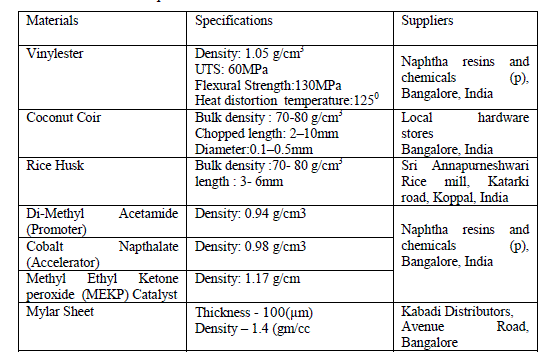 |
| B. Processing of Coir & Rice Husk/Vinylester Composite. |
| Coir Composite is prepared first to know at what percentage of weight fraction the composite gives the Ultimate Tensile Strength from that percentage some percentage of Rice Husk is added to enhance its tensile property. First make some sample preparation calculation before preparing the composite as given below and start the fabrication by preparing the temporary mould using beadings arranged on the granite base representing a rectangular mould of 300x300x5mm. Pour the calculated amount of resin with thoroughly mixed Promoters, Accelerators & Catalyst of 1% to the mould and wait for ten minutes so that it starts pre hardening then put a Mylar sheet on to it and then apply pressure by placing a concrete block over the setup for 24 hours to complete cure the laminate and once the laminate is completely cured then itâÃâ¬ÃŸs ready for machining according to ASTM standard for testing, repeat the procedure by adding 5, 10, 15, 20% wt of Coir fiber to the resin. At optimum percentage then add 1, 3, and 5% of Rice Husk and repeat the same procedure to get the Hybrid composite and is tested for mechanical properties. |
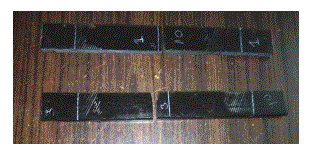 |
| C. Sample Preparation |
| Composite laminate of 300 mm X 300 mm X 5 mm were fabricated according to ASTM standards for mechanical tests. |
| 1) Density of Vinylester (δ) = 1.05 g/cm3 |
| 2) Volume of the mold (V) = 300x300x5mm |
| = 450000mm3 |
| = 450cm3 |
| 3) Mass of resin (m) =Volume of mould x Density of Vinylester |
| = 450cm3 x 1.05g/cm3 |
| = 472.5g ≈ 500g. |
 |
| The above samples are tested for mechanical properties that are tensile and flexural strength according ASTM standards. |
MECHANICAL CHARACTERISATION |
| Composite materials were subjected to various mechanical tests to measure strength, elastic constants, and other material properties. The results of such tests were used for two primary purposes: 1) engineering design (for example, failure theories based on strength, or deflections based on elastic constants and component geometry) and 2) quality control either by the materials producer to verify the process or by the end user to confirm the material specifications. A Universal Testing Machine (UTM) is an instrument used for the measurement of loads and the associated test specimen deflections such as those encountered in tensile, compression or flexural modes. It is used to test the tensile, compression, flexural and Inter Laminar Shear Strength (ILSS) properties of materials. Load cells and extensometers measure the key parameters of force and deformation as the sample was tested. The Universal Testing Machine set up is shown in Fig.2 (a) |
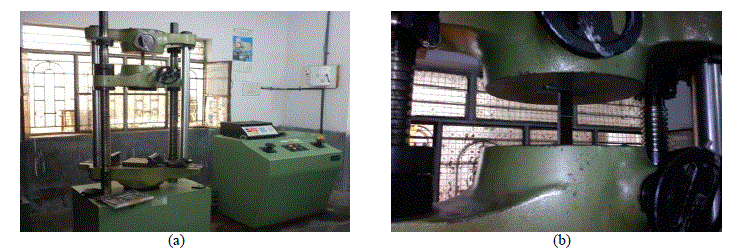 |
| A. Ultimate Tensile Strength |
| Ultimate tensile strength, often referred to tensile strength is the maximum stress that a material can withstand while being stretched or pulled before fracture. The tensile test for the specimens was conducted according to ASTM D3039. The specimens of size 250 mm x 25 mm x 10 mm were tested with a span length of 250 mm in tensile mode at a cross head speed of 1 mm / min. The fixtures used for the tensile testing is shown in Fig. 2(b) |
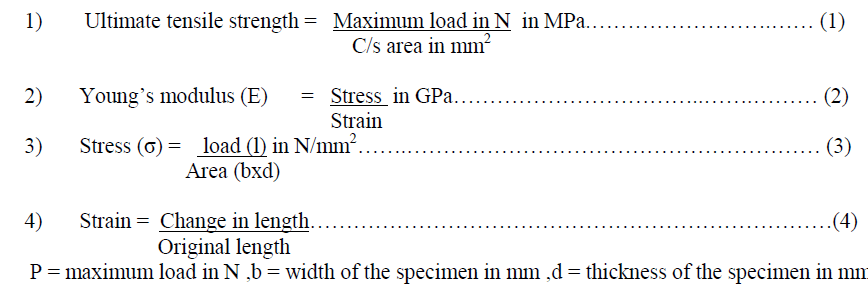 |
| B. Tensile Test Report |
 |
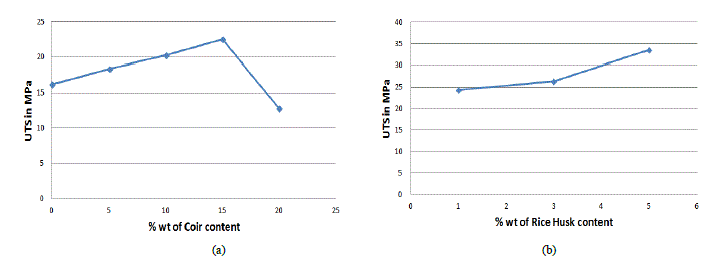 |
| C. Flexural Strength |
| The use of flexural tests to determine the mechanical properties of polymeric composites is widely prevalent because of the relative simplicity of the test method, instrumentation and testing equipment required. The flexural strengths of the specimens were determined for specimens using the three-point bending test as per ASTM-D790. The specimens of dimensions 200 mm x 15 mm x 5 mm tested with a span length of 50 mm. The flexural strength and Modulus of the composites were determined using the equation (1) & (2) respectively. |
 |
| D. Flexural Strength Coir / Vinylester Composite |
| The use of flexural tests to determine the mechanical properties of polymeric composites is widely prevalent because of the relative simplicity of the test method, instrumentation and testing equipment required. Table VI & VII. List the flexural strength of Coir / Vinylester composite & Coir & Rice Husk/Vinylester composite |
 |
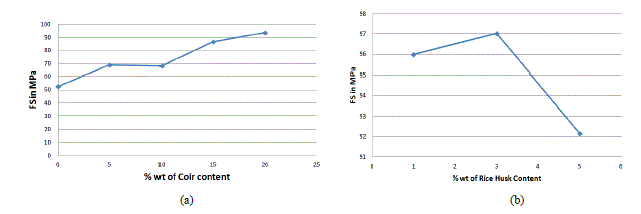 |
| Fig.4 Graph of Bending test results. (a) Variation of UFS values with coir fibre loading. (b) 7 Variation of UFS values with Rice Husk loading. |
MORPHOLOGICAL CHARACTERISATION |
| Nano level materials cannot be observed through optical microscope due to their aberrations and limit in wavelength of light. Therefore to observe submicron sized particles advanced techniques such as Scanning Electron Microscopy (SEM), Transmission Electron Microscopy (TEM), Scanning Tunneling Microscopy (STM), and Atomic Force Microscopy (AFM). In this work, the dispersion of Coir & Rice Husk in Vinylester resins was studied using SEM. The basic principles of these techniques are presented in the subsequent sections. |
| E. Scanning Electron Microscopy (SEM) |
| From the microstructure it is evident that there is inhomogeneous mixture of Coir & Rice Husk/Vinylester that leading to some voids/pores in the matrix as shown in fig. (b). There are some micro cracks in the matrix material which is responsible for reduction of tensile strength of the composite as seen in fig. (c). There is gap surrounding the reinforcement indicating the poor bonding reinforcement and matrix. Poor interfacial bonding results decrease in strength of composite as shown in fig. (h) it is found to have good interfacial bonding and no micro cracks which has given the composite little positive strength to the tensile load as shown in fig. (e). |
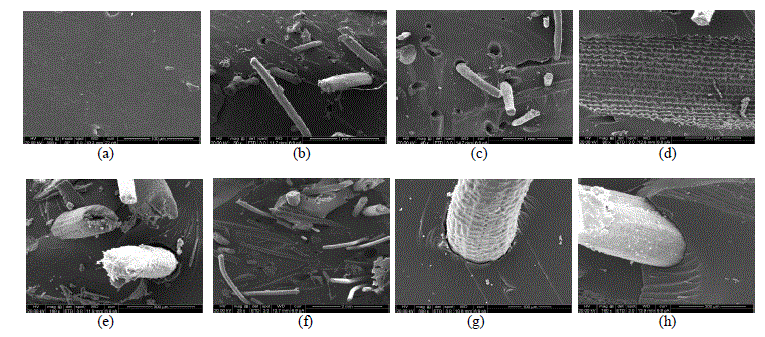 |
CONCLUSION |
| The conclusion of the study of Coir & Rice Husk reinforced vinyl ester composite is that there is significant increase in the flexural strength of the composite whereas it loses its tensile strength at 20% wt Coir fiber loading. Flexural strength of the composite increases but decrease at 5% wt of Rice Husk fiber loading. |
| 1. With the addition of Coir to the Vinylester the tensile strength increases by 27.80% at 15% fiber loading and decrease at 20% wt of coir loading by 20.85% so further addition of coir will no longer increases the strength rather it decreases. |
| 2. With the hybridization I.e. by the addition of Rice Husk at optimum point it increase the tensile strength by further 7.64% hence hybridization successfully yield more strength compare to single fiber loading |
| 3. The flexural coir composite increases by 39.40 at 15% coir loading and 43.84% at 20% coir loading. |
| 4. The flexural strength increase further by 9.78% at 1% Rice Husk, 10.74% at 3% Rice Husk, 6.02% at 5% Rice Husk addition this means addition of Rice Husk more than 3% results decrease of flexural strength hence hybridization more than 3% wt fiber loading reduces the flexural property. |
| 5. From the SEM its clear that there some voids/pores, Micro cracks, poor interfacial bonding which are the cause for reduced strength which can be overcome by employing other fabrication technique and by mixing the contents thoroughly using mechanical stirrers. |
| 6. Hybridization results a better improvement in tensile strength but more than 3% of Rice Husk is not recommended where the flexural property is needed for the application. |
| 7. Random oriented coir fiber–polyester composites are low-strength materials, but can be designed to have a set of flexural strengths that enable their use as non- structural building elements. |
ACKNOWLEDGMENT |
| I am thankful to the Department of Mechanical Engineering staff and also Prof.Udayakumar P A GSS institute of technology for their support to carry out this research work. |
References |
|